Reader Survey: Pallets as a reflection of your business
Modern’s annual reader survey shows how trends in pallet use point to priorities around cost control, customer compliance and operational efficiencies. More customers are asking for pallet type changes and having minor availability issues with used wood pallets, while pallet cost and durability continue to be dominant decision factors.
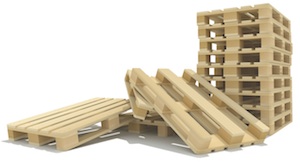
With most everything supply chain, if you follow through on what the customer wants, and do it at a low cost, you are usually going to come out on top. Perhaps it’s no surprise then, that Modern readers’ pallet usage reflects these fundamental aims of supply chain management.
For Modern’s annual survey of readers who use pallets, Peerless Research Group surveyed subscribers of Modern as well as a sample of recipients of our e-newsletters. We received 355 qualified responses from those employed at a location that uses pallets.
Respondents reported that purchase price was once again the leading decision factor with a 60% response rate, followed by strength and durability. Yet pallet choice isn’t quite as simple as choosing the strongest, lowest-cost option. Respondents also reported a slight increase in customer-driven pallet requirements. When asked if customers had asked for changes in pallet usage during the past 12 months, less than 17% affirmed there had been customer requests for change, compared to just more than 15% who answered “yes” to that question in the 2014 survey.
This uptick in customer-driven pallet change may be slight, but it is consistent with the dual supply chain pressures of having to respond to what customers want, and do it at a low cost. In other words, use of the humble pallet often mirrors broader supply chain pressures, most of which are customer-driven, according to the “2015 MHI Annual Industry Report.” The report found that “customer pricing pressure” and “rising customer service expectations” were two of the top three most challenging issues for supply chain professionals.
Modern’s 2015 pallet user survey also points to how pallet rental and pooling strategies continue to evolve as companies look for ways to ensure pallet availability while controlling costs and outsourcing much of the work involved with pallet management.
In other key trends from the 2015 survey, wood pallets continue to dominate the market, but respondents report at least some availability issues with used wood pallets, more purchasing of new wood pallets, while use of block pallets gained some ground on use of stringer pallets. The percentage of readers saying they expect to use more plastic and metal pallets over the next 12 months also saw upticks.
Readers also reported a slight increase in international pallet shipments, though most do not see this rising much over the next two years. Other sources, such as research firm Freedonia Group, predict a growing pallet market worldwide, with 5% annual sales growth expected through 2017.
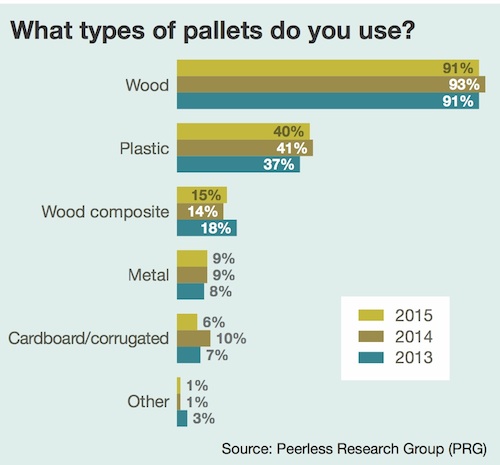
Purchasing priorities
Respondents were asked to choose between multiple factors driving their choice of pallet. Once again, purchase price was the most frequently named driver, with a 60% response rate. Other leading factors include:
58% strength,
48% durability,
41% reusability,
40% customer requirements,
36% cost per use, and
32% availability.
Most of the purchase influence factors remained near the same response level as last year, with some minor variations. For example, durability dropped from 54% in 2014 to 48% this year, customer requirements dropped by 5%, and “reusability” was at 41% this year versus 44% last year. In the other direction, recyclability rose from 20% last year to nearly 27% this year, and “weight” bumped up by 2% as a decision driver.
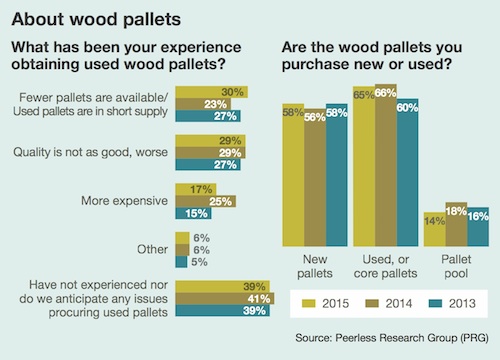
Wood pallets are used by 91% of readers, down slightly from 2014’s 93% response. Alternative materials are also commonly used, including:
40% plastic pallets,
15% wood composite,
6% cardboard/corrugated, and
9% metal.
Use of alternative materials experienced only minor changes in response rates versus 2014’s survey. For instance, use of wood composites is up from just less than 14% last year to 15% this year. Use of cardboard/corrugated pallets was down close to 3%, while those reporting use of plastic and metal pallets was down by less than 1%.
While slightly smaller percentages of Modern’s readers reported current use of plastic and metal pallets, the outlook for using more pallets made from alternative materials was on the upswing. For instance, 34% say they expect to use more plastic pallets during the next 12 months, up from 30% in 2014’s survey. While a majority of respondents said plastic pallet use would “stay the same” (57%) only 8% forecast a decrease in their use.
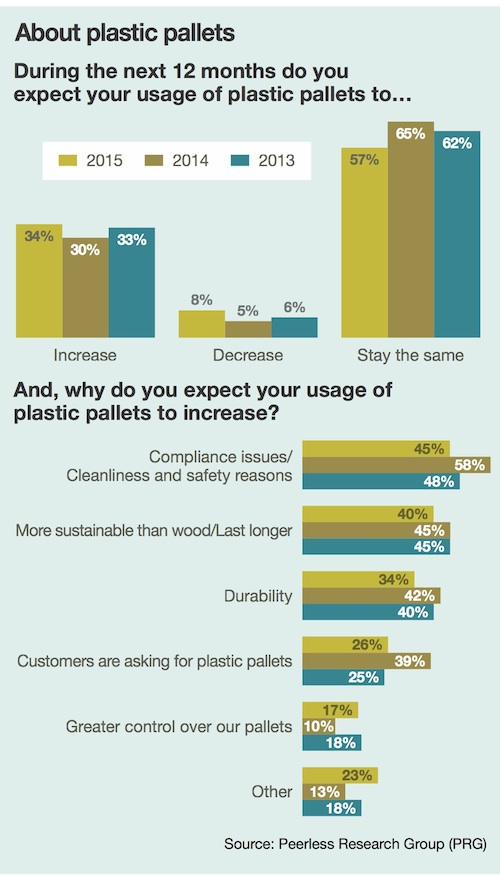
The top reasons for plans to use more plastic pallets were “compliance and cleanliness/safety” (45%) followed by “more sustainable than wood/last longer,” named by 40%. Other reasons cited for plans to use more plastic pallets included:
• plastic pallets are more durable than wood (34%),
• customers are asking for plastic pallets (26%), and
• greater control over our pallets (17%).
Plans to use metal pallets are on the upswing. Of those respondents already using some metal pallets, 21% say they expect to increase metal pallet use, 68% expect usage to stay the same, and 9% expect some decrease. That’s a significant increase over the 8% of metal pallet users who last year said they expected increased use, although the raw numbers of respondents for this question was small in both years.
The 48 x 40-inch pallet is easily the most commonly used pallet size, cited by 86% of readers. This was consistent with the 84% of readers that reported using 48 x 40-inch pallets last year. Just more than 19% of readers are using the 42 x 42-inch size, while more than 14% reported using 48 x 48-inch pallets. Less than 5% are using 24 x 20-inch half pallets.
The number of respondents using pallets to ship internationally (taking into account those that ship both domestic and international, and those that ship solely internationally), was less than 61%, up from 57% the previous year. Domestic shipping by pallet stood at 39% this year, down from 44% last year. Only 3% ship on pallets solely to international customers.
The leading countries/regions to which goods are shipped continue to be those with U.S. borders, with 80% of readers shipping to Canada, down from 87% the previous year, followed by 71% shipping to Mexico/South America/Caribbean, down from 82% in 2014. The percentage of readers shipping to Western Europe is at 45%, down from 52% last year, while 33% of readers ship to Eastern Europe, down from 41% last year.
While less than half of respondents (35%) said the number of pallets they ship internationally has increased during the past two years, readers are more optimistic for the next two years, with 45% saying they expect to ship more pallet loads internationally.
Readers may do some things differently when shipping pallets globally, with only 23% reporting that they don’t do anything differently. Some of the strategies include:
39% treat their pallets,
12% use alternative materials other than wood that don’t require treatment,
23% use wood pallets from their own pool, and
more than 4% use a pallet pool for international shipments.
Wood pallet highlights
With 91% of readers reporting wooden pallet use, this traditional material remains nearly universal. A notable trend with wood pallets is some increase in availability challenges for used wooden pallets, as well as slightly more use of new pallets, which is perhaps not surprising given the economic growth of the last couple of years coming off of a deep recession.
When asked to describe their usage level for used wood pallets, 65% of respondents said they purchase used pallets, nearly even with last year’s 66% who bought at least some used wood pallets. New pallets were purchased by 58% of readers, up from 56% last year.
When asked to describe their level of use for wood pallets, only 39% of readers said they were using more of them, a decrease of 14% from last year’s 53% response. More than 13% say they are using fewer used wood pallets, up 2% from last year.
When asked what their experience has been this year in obtaining used wood pallets, more than 30% said there are fewer available, up from 23% in 2014. However, 17% report used wood pallets are more expensive this year, which actually is a decrease from 25% last year. Additionally, the proportion of respondents reporting no issues procuring used wood pallets held fairly steady at close to 40%.
In response to availability issues with used wood pallets, 53% of readers say they will buy more new pallets, and 18% say they plan to create and manage their own pools. Additionally, 9% say they plan to rent from a pallet pool such as those from CHEP, PECO and iGPS. These percentages were nearly identical to the responses from the 2014 survey.
Block pallets gain
Several years ago, when retailer Costco began requiring block pallets, the thinking was that other major retailers of groceries and consumer goods would follow suit and trigger a major move to the block pallet versus the more traditional stringer pallet design. That major move hasn’t materialized, but block pallets have gained a toe hold on the market, and this year’s survey results indicate greater uptake for the design. That said, the stringer pallet remains the mainstay design.
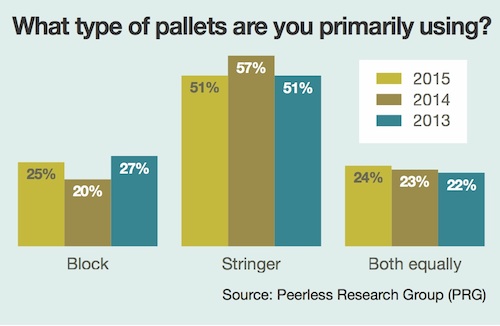
This year, 25% of readers say they are primarily using block pallets, up from 20% in the 2014 survey. And, 51% of readers say they are shipping primarily on stringer pallets, down from 57% last year, while the percentage of respondents saying they use both equally stood at less than 24%, less than half of percentage point increase from 2014.
While these results might appear to indicate a significant move to block pallets, only 27% of respondents say they are using more block pallets this year, which is 10% less than the 37% who last year said they were using more block pallets. However, 17% of readers answered “yes” to “have customers have required changes to pallet use?” up from 15% who answered yes to this question in 2014.
Changes are being requested from a variety of points in the supply chain:
• manufacturer (33%),
• retailer (35%), and
• wholesaler (28%).
The biggest change in the type of trading partner requesting a change in pallet use is from manufacturers, with a 9% decrease in requested change from manufacturers. Change requests from retailers increased, from 29% last year to 35% this year.
Pooling/rental evolution
Pallet rental and pooling solutions are a way of addressing availability and predictable costs, while allowing users to focus more attention on what they see as the core challenges of moving goods and filling orders. While pooling and rental approaches have seen significant increase in sectors such as consumer goods and grocery, many facilities still continue to buy and manage their own pallets. At the same time, use of rental, recovery and pooling approaches continue to evolve.
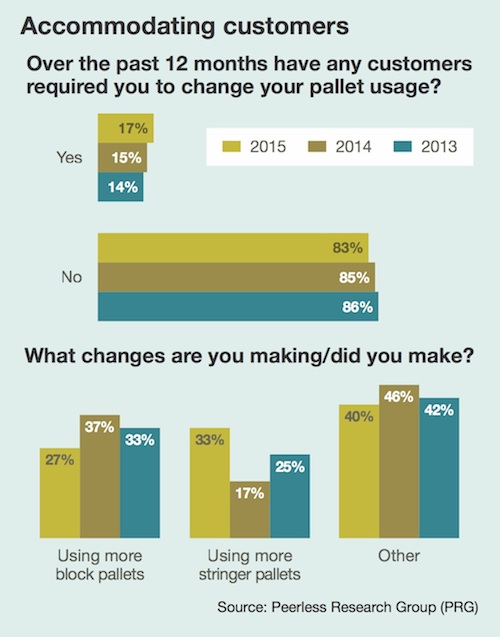
When asked if their companies rent pallets, plan to rent, or use a retrieval/recovery provider, 29% of readers say they use a pallet rental company, down sharply from 50% last year. However, another 29% this year say they are using another type of pallet retrieval or recovery system, up sharply from 7% last year, so the combined use of some type of rental or recovery solution actually remained fairly steady, with only 41% saying this year they do not use one of these two approaches, compared to 43% last year.
Looking forward, more than 21% of respondents say they are highly likely or likely to consider participating in a pallet retrieval/recovery system or in a third-party pallet rental system during the next year, up from 17% last year. At the same time, 68% say they are “not very likely” or “not at all likely” to participate in one of these approaches, a slight decrease from 71% of respondents last year. So while it’s not exactly a big bump in plans to rent or pool, these findings can be taken as some indication of continuing acceptance for these approaches.
When asked whose pallet rental or pallet management system they participate in or would consider, the leading answer at 51% was “self-managed,” down from 62% last year. Meanwhile, 28% of respondents say they have evaluated or considered a solution for managing their own pool, up from 26% in 2014.
When readers were asked how interested they would be in using a pallet pooling service managed by the pallet industry as an alternative to established pools managed by CHEP, PECO and iGPS, more than 14% are “interested,” and 2% are “highly interested,” compared to less than 7% interested and less than 2% very interested last year, so an increase of roughly 7% in interest when combining these two selections year over year. Still, nearly 61% this year said they are “not very” or “not at all” interested in this type of service.
Pallet management trends mirror the cost conscious, customer-driven nature of supply chain management, even if many logistics and warehouse professionals would rather have someone else handle pallet management for them. But with a growing economy, and more respondents indicating at least some availability issues with used wooden pallets, as well as more customer-driven change in pallet types, staying current on pallet trends remains important to meeting basic aims of cost control and customer service.

Article Topics
Latest in Logistics
Key benefits of being an Amazon Business customer with Business Prime USPS cites continued progress in fiscal second quarter earnings despite recording another net loss U.S. rail carload and intermodal volumes are mixed, for week ending May 4, reports AAR New Ryder analysis takes a close look at obstacles in converting to electric vehicles Norfolk Southern shareholders sign off on 10 board of directors nominees Between a Rock and a Hard Place Inflation and economic worries are among top supply chain concerns for SMBs More LogisticsAbout the Author
Subscribe to Logistics Management Magazine

Find out what the world's most innovative companies are doing to improve productivity in their plants and distribution centers.
Start your FREE subscription today.
May 2024 Logistics Management

Latest Resources














